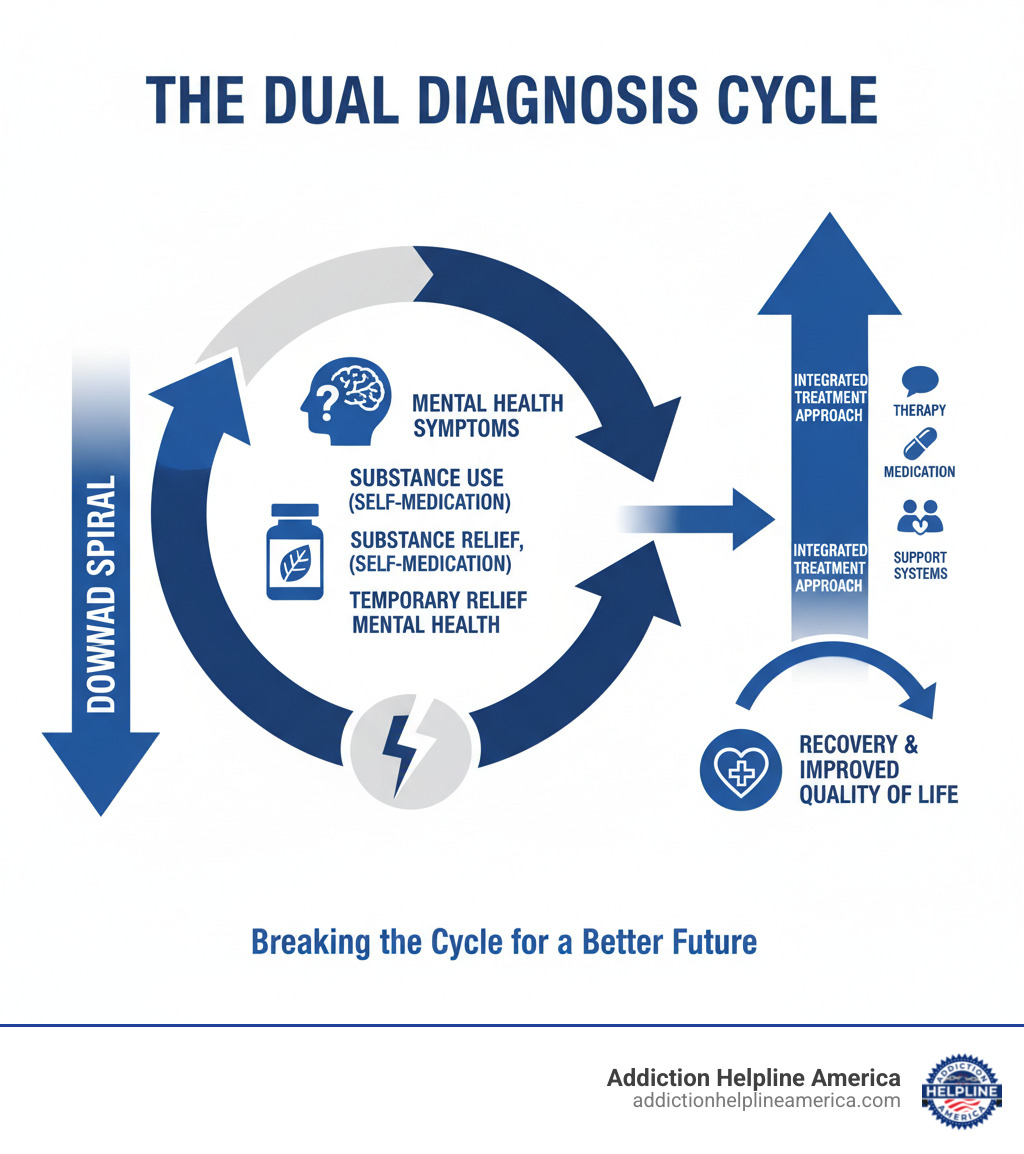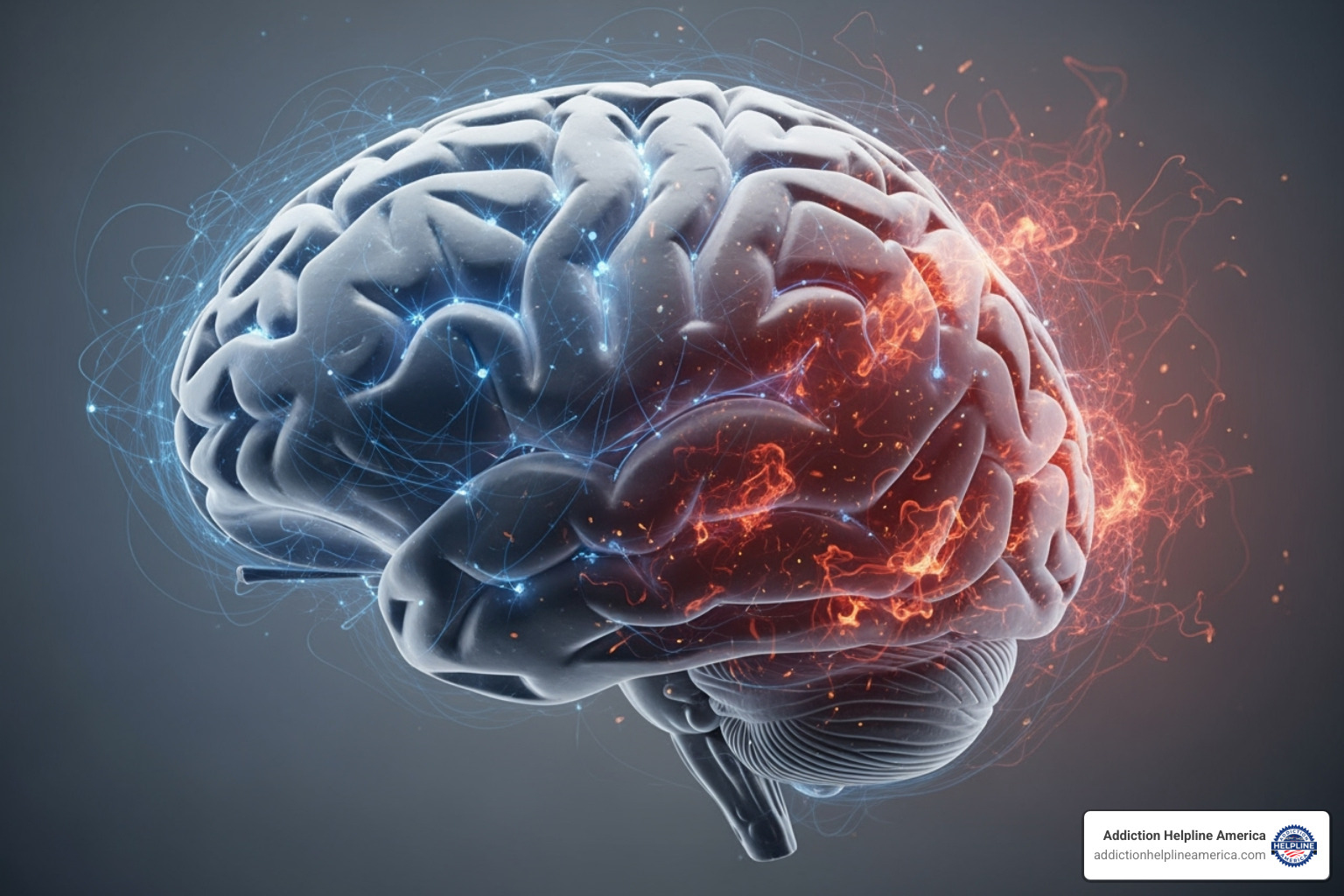Your Journey to a Healthier Life Starts Here
Free Insurance Verification
Verify Your Treatment Coverage
Verify Your Treatment Coverage
Dual Diagnosis Treatment is specialized care for people who have both a mental health disorder and a substance use disorder at the same time. This approach treats both conditions together, not one after the other.
Quick Facts About Dual Diagnosis Treatment:
If you or someone you love is struggling with both addiction and mental health challenges, you’re not alone. For many years, the medical system treated these problems separately—often making people get sober first before addressing their depression, anxiety, or trauma. This approach rarely worked.
Why? Because mental health symptoms and substance use feed off each other in a vicious cycle. You might drink to escape anxiety, but alcohol makes anxiety worse. You might use opioids to numb emotional pain from PTSD, but the addiction creates new trauma. One condition makes the other worse, and the cycle continues.
The good news: integrated treatment breaks this cycle. Research from the 1990s proved that treating both conditions at the same time leads to better, longer-lasting recovery. Today, this is the gold standard of care.
At Addiction Helpline America, we’ve dedicated our work to connecting individuals and families with compassionate, evidence-based Dual Diagnosis Treatment resources that address both mental health and addiction together. Our team of specialists understands that recovery requires treating the whole person, not just isolated symptoms.

When you’re dealing with both a mental health condition and an addiction, it can feel like you’re trapped in a maze with no exit. You might try to address one problem, only to have the other one pull you back. This is the reality for millions of people living with what we call a Dual Diagnosis Treatment need—and understanding why these conditions occur together is the first step toward real healing.
Think of it this way: imagine trying to bail water out of a boat while there’s still a hole in the hull. You might make some progress, but you’ll never truly fix the problem until you address what’s causing the leak in the first place. For decades, that’s exactly how we treated people with co-occurring disorders—trying to fix one problem while ignoring the other. It didn’t work then, and it won’t work now.
The integrated treatment model changed everything. Instead of treating addiction and mental health as separate issues, this approach recognizes what we now know to be true: these conditions are deeply connected, and they need to be treated together. Your mind and body aren’t separate entities—they’re part of one system, and when one part struggles, the whole system feels it.

A co-occurring disorder, or dual diagnosis, means you have both a mental health disorder (like depression, anxiety, or PTSD) and a Substance Use Disorder (addiction) at the same time. The Substance Abuse and Mental Health Services Administration (SAMHSA) uses the term “co-occurring disorders” to describe this.
These conditions are intertwined in a vicious cycle, where the symptoms of one worsen the other. For example:
The National Institute on Drug Abuse (NIDA) offers more information on these complex relationships on their page about common co-occurring disorders and health conditions. Understanding these connections shows why treating both is essential.
Historically, the medical system required patients to get sober before their mental health could be addressed. This sequential approach was largely a failure. Asking someone to quit their primary coping mechanism (substances) without treating their underlying anxiety or trauma often led to relapse.
The 1990s brought a revolution in thinking, with research proving the sequential model was ineffective. This led to a shift toward integrated care, where both conditions are treated at the same time, by the same team. When people received simultaneous treatment, they began to understand the interplay between their conditions and learned healthier coping skills, leading to better outcomes and a real chance at lasting recovery.

Take the first step towards a healthier life! Call now to connect with our compassionate team and start your recovery journey today. Your path to healing awaits!
Our recovery specialists are available 24/7 to provide support, and all calls are confidential and free. Reach out anytime – we’re here to help!
The link between mental health and addiction isn’t random. Several factors explain why they often appear together:
For most people, it doesn’t matter which condition came first. Both exist, they fuel each other, and they both require comprehensive care. That is what Dual Diagnosis Treatment provides.
Effective Dual Diagnosis Treatment requires a personalized plan that understands how mental health and substance use feed off each other. About 50% of people with co-occurring disorders respond well to combined treatment programs, largely because a cohesive team works together to address both conditions at once. The goal is comprehensive care that leads to lasting recovery, not just temporary sobriety.

The integrated approach is the gold standard for Dual Diagnosis Treatment. It recognizes that mental health and substance use are interconnected and must be treated simultaneously. Treating only one condition often leads to relapse, as the untreated issue undermines progress.
This approach involves:
This seamless coordination provides the best possible chance of building a healthier, more stable life.
Effective treatment relies on therapies backed by research and real-world results. These therapies provide a toolkit for managing symptoms and building a foundation for healing.
These therapies are often delivered in both individual and group settings. You can learn more about these and other approaches through SAMHSA’s overview of evidence-based practices for co-occurring disorders.
For many, medication is a crucial piece of the recovery puzzle. It’s not about replacing one drug with another; it’s about stabilizing brain chemistry so that therapy can be effective.
Medication can:
Working with specialists is key to finding non-addictive medication options and ensuring proper use. Medication management requires regular monitoring by a psychiatrist to adjust dosages and ensure the treatment plan is working. When integrated with therapy, medication provides a powerful foundation for stability. At Addiction Helpline America, we connect you with programs that offer this comprehensive approach.
Recovery is a lifelong journey, not a destination. The intensive work done in treatment provides the tools, but the real change happens in the weeks, months, and years that follow. This ongoing phase, known as aftercare, is where you apply what you’ve learned to real life, and you don’t have to do it alone.

Leaving a structured treatment environment can be daunting. A solid support system is your safety net for navigating the pressures of daily life.
This support system isn’t just about preventing relapse; it’s about building a new, fulfilling life.

Take the first step towards a healthier life! Call now to connect with our compassionate team and start your recovery journey today. Your path to healing awaits!
Our recovery specialists are available 24/7 to provide support, and all calls are confidential and free. Reach out anytime – we’re here to help!
Finding the right program is critical for a successful recovery outcome. Start with a professional assessment to identify your specific mental health and substance use disorders.
Next, consider the level of care you need:
When evaluating programs, ask about their licensing, their specific approach to dual diagnosis, program length, and aftercare support. Ensure the staff is specifically trained in co-occurring disorders. The Substance Abuse and Mental Health Services Administration (SAMHSA) has a treatment locator tool to help your search.
At Addiction Helpline America, we simplify this process with free, confidential guidance, connecting you to a program that fits your unique needs.
Watching a loved one struggle is heartbreaking. While you can’t force them into recovery, you can create an environment that supports healing.
Navigating a dual diagnosis can be confusing. Here are answers to some of the most common questions we hear.
This is a classic “chicken or the egg” question, and the answer varies. Sometimes, a mental health issue like depression or anxiety leads to substance use as a form of self-medication. Other times, chronic substance use changes brain chemistry and triggers a mental health disorder.
Often, both develop around the same time, feeding off each other. For effective Dual Diagnosis Treatment, it doesn’t matter which came first. What matters is that both conditions are present now and need to be treated simultaneously to break the cycle.
Recovery is a lifelong process, but the outlook for Dual Diagnosis Treatment is hopeful. Research shows that about 50% of people with co-occurring disorders respond well to combined treatment programs that address both conditions at once.
“Success” means more than just abstinence. It means managing mental health symptoms, developing healthy coping skills, and living a fuller, more stable life. Success depends on the quality of the program, individual commitment, and strong aftercare support. Setbacks can happen, but they are part of the process, not a failure.
This depends on the impact the substance use is having on your mental health. If your use—even if you consider it “recreational”—is negatively affecting your mood, relationships, or making mental health symptoms worse, then an integrated approach is beneficial.
For some, what starts as casual use is actually a way to self-medicate an underlying issue. For individuals with conditions like bipolar disorder or schizophrenia, even minor substance use can be destabilizing. The best way to know for sure is to get a professional assessment. A qualified professional can evaluate how your substance use and mental health interact and recommend the appropriate level of care.
When in doubt, seeking an assessment is the safest choice. At Addiction Helpline America, we can connect you with professionals who can provide that evaluation. You can find support and answers at addictionhelplineamerica.com
If you’ve read this far, you understand that Dual Diagnosis Treatment is a lifeline that addresses the whole person. You’ve seen how mental health and substance use disorders create a vicious cycle, but you also know that this cycle can be broken.
Recovery is absolutely possible.
Modern integrated care has replaced the old, fragmented approach. By treating both conditions at the same time, healing becomes not just possible, but probable. You don’t have to figure this out alone.
At Addiction Helpline America, our mission is to ensure everyone has access to compassionate, evidence-based care. We know that taking the first step is hard. You may be worried about cost, finding the right program, or just feel scared. That’s why we’re here.
We offer free, confidential guidance to help you steer your options and connect with a trusted treatment center from our network. No judgment, no pressure—just real people ready to help you find a personalized program that addresses both your mental health and substance use challenges.
A healthier future is waiting. It starts with reaching out.
Find a dual diagnosis program now and let us walk with you on the path to integrated healing. You deserve this chance.
Are you or a loved one struggling with addiction? Call today to speak to a treatment expert.
Calls to any general helpline will be answered or returned by one of the treatment providers listed, each of which is a paid advertiser:
Our helpline is available 24 hours a day, 7 days a week at no cost to you and with no obligation for you to enter into treatment. We are committed to providing support and guidance whenever you need it.
In some cases, Addiction Helpline America charges our verified partner a modest cost per call. This fee helps us cover the costs of building and maintaining our website, ensuring that we can continue to offer this valuable service to those in need.
Calls to the general helpline will be answered or returned by one of the listed treatment providers, all of whom are paid advertisers.
By using the helpline, you agree to the terms of use. We do not earn any commission or fee based on the treatment provider selected by the caller, and there is no obligation to pursue treatment.
This service is not affiliated with Alcoholics Anonymous World Services, Inc.